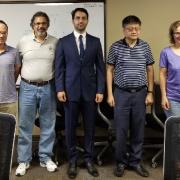Congratulations to Kamran for passing his PhD defense; Welcome to the Doctors' Club!
2019
ADVANCED NANOFABRICATION METHODS FOR THE FUNCTIONALIZATION OF CARBON-BASED MATERIALS
Abstract of thesis:
This document presents a number of nonconventional fabrication/processing techniques developed for the integration of the emerging carbon-based nanomaterials, including carbon nanotubes (CNTs) and graphene, and realization of their superior properties, thereby addressing some of the fundamental challenges in industrial applications. According to recent studies, CNTs possess extraordinary properties that make them promising candidates for improving the performance of a wide range of industrial applications. However, practical realization of these properties and the integration of the carbon-based nanomaterials through conventional fabrication methods has proven to be a challenging task in terms of quality control, reproducibility, and cost effectiveness.
To address these challenges, this dissertation proposes the development and implementation of scalable, cost-effective processing approaches to the integration of carbon-based nanomaterials into industrial applications. The following research topics are covered in this dissertation: 1) suppression of the eddy current loss in laser-processed multi-walled carbon nanotube (MWCNT)-coated copper (Cu) conductors, 2) neutralization of electrical arcing in CNT-implanted rails, and 3) ultralow contact resistance in graphene-based devices via laser-assisted nanowelding.
Successful suppression of ac resistance of up to 94% was realized in MWCNT-coated copper (MWCNT-Cu) planar conductors at high operational frequencies (0-15 MHz) through electrophoretic deposition and infrared laser treatment of MWCNT coatings on Cu. In addition, this scalable method was used to reduce the eddy current loss and increase the transmission range in wireless power transfer (WPT) systems. The quality factor of the MWCNT-Cu coils increased by fourfold compared to their metallic counterparts, thereby leading to transmission efficiencies as high as 95.81% at f = 3.45 MHz.
A scalable laser drilling/MWCNT implantation method was also successfully developed to neutralize the destructive electrical arcing in third-rail systems. The highly conductive MWCNT composite in the microholes was observed to weaken and divide the arcing current density into harmless magnitudes, thereby minimizing the arc-induced surface damage.
Finally, a contact-free, position-selective, and highly accurate laser-assisted nanowelding technique was developed to reduce the graphene-metal (G-M) contact resistance, leading to values as low as 2.57 Ω-µm. This was achieved through formation of laser-induced defects in order to increase the chemical reactivity of graphene and facilitate the G-M bonding, thereby maximizing the interfacial transportation.
